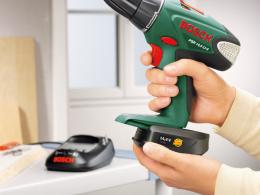Search
Login
Batteries for screwdrivers, how to choose
The use of batteries in power tools is both an advantage and a disadvantage. The advantage is clear: isolation from the mains, the ability to work in hard-to-reach places, etc. Nevertheless, the battery is the weakest link in any screwdriver. This means that the selection of the battery must be approached with the same scrupulousness as the choice of the screwdriver. So what type of battery to choose and what to do if it fails? Let's try to figure it out.
Content
We select the type of battery
The choice of this criterion will, first of all, be based on the amount available to you and the estimated frequency of use of the screwdriver. To date, screwdrivers are equipped with three types of batteries.

Nickel Cadmium - A morally obsolete option, but still competes with its more modern brothers. Its use is due to low cost. It is two to three times cheaper than metal hydride counterparts. The difference in price with other types of batteries is even more significant. The main disadvantage is the so-called memory effect, which, if the charge / discharge cycle is not observed, significantly reduces the capacity. Until the failure. It also has a high level of self-discharge.

Nickel Metal Hydride In this type of battery, the disadvantages of Ni Cd batteries are significantly minimized. The memory effect is much less pronounced, but not completely removed. The battery capacity has increased, and self-discharge has also been significantly reduced. But naturally, these batteries are more expensive than nickel - cadmium analogues.

Li-ion There are completely no shortcomings of previous types of batteries. But it also has its weaknesses. So Li-ion batteries do not tolerate a full discharge or vice versa recharge. They simply collapse (and explode). Accordingly, this increases the technical requirements for the charger. Significantly more expensive than Ni Cd and Ni MH analogues.
In the future, the fourth type of battery is available - lithium iron phosphate. They are already used as batteries, but have not yet reached the tool. This is due to the high cost of batteries. A feature of this type are large discharge currents (up to 30A) and a long life (promise 2000 charge / discharge cycles).
To summarize all of the above, it is more advisable to purchase with a Ni MH battery for domestic needs. It costs significantly less, and in case of failure it will always be possible to re-solder the battery assembly. Overpaying for an instrument that most of the time will simply lie on a shelf is simply not advisable. In addition, if you purchase an intelligent charger such as La Crosse Technology BC-700, then most of the shortcomings of these types of batteries can be removed with just a few clicks of buttons. But it's up to you to decide.

If the screwdriver will be used constantly, then it is better to stop your choice on a lithium-ion battery. They have good capacity, you can put on charging in the intervals between work. Yes, and a more compact and light tool with prolonged use will be better.
What affects battery capacity

The higher this indicator, the longer the screwdriver will work. This indicator indicates how many hours the battery is capable of providing maximum discharge current. Measured in mA / h. Running a little ahead, we note that when repairing a battery, if it is necessary to replace individual elements, they should all have the same capacity. Serial connection of batteries with different capacities is not allowed.
Nickel-cadmium batteries have the smallest capacity. The largest capacity is lithium based. This does not mean that the capacity of nickel cadmium batteries is not enough for domestic needs. It is quite enough if your house does not have a carpentry workshop or if you do not build a house. In addition, if we talk about the price, then for the amount of a screwdriver with a lithium-ion battery, you can choose a screwdriver with two nickel-cadmium or metal hydride batteries. It will also remain.
Screwdriver Battery Repair
All battery packs for screwdrivers are assembled from separate elements, as a designer. The voltage indicated on the unit is total. If our battery is nickel cadmium, then the rated voltage on the bank is 1.2V. For Li-ion - from 3.3V. Therefore, to obtain a voltage of 14V, it is necessary to connect the battery cells in series (with this connection, all voltage is summed). So for 14V we need 12 cans of Ni-Cd or 4 cans of Li-ion.

So, we consider battery repair based on Ni Cd and Ni-MH cells. For this we need:
- Intelligent charger like La Crosse Technology BC-700 (costs about $ 30, but worth it);
- A set of batteries is best purchased with a margin and with soldered ends, for example, we need 12 elements per block, and it is better to buy 15 20 pieces (not all elements are operational);
- Soldering iron, rosin or flux LTI 120.
We take new elements and a charger like La Crosse Technology or Maha Powerex. Then we discard jars with a low capacity, this is not uncommon.

A small digression about smart chargers. A standard battery charge for a screwdriver is only good for the current battery charge. While smart devices allow you to measure capacity, eliminate the effect of memory, conduct charge / discharge cycles, measure the voltage on the bank, control the charging current, etc. All this can be done manually, but for this you will need an intelligent multimeter and electronic engineer skills. In addition, these devices are useful not only when repairing a screwdriver.

So, we reject all elements with low capacity and other defects by charging La Crosse. For the selected elements, we carry out several charge / discharge cycles using the same device as is required for this type of battery.

Next, the selected elements are connected in series using the bus. Those. plus battery connects to minus next battery, etc. Try not to overheat the surface of the battery, insulation may be broken and, accordingly, it will fail. To solder with rosin, take a file and clean at the intended connection point. Very rarely when after this rosin can not cope. If it doesn’t help, then we use flux.
We connected it, now we assemble the battery case and use it. This type of work is not at all complicated. All items can be purchased without leaving home. In addition to the charger, such repairs will cost no more than 600 rubles.
Replacing lithium-ion batteries is a little more complicated, as is reworking the unit for other types of batteries. And it turns out to be more expensive, therefore its technology and expediency is the topic of a separate article.





